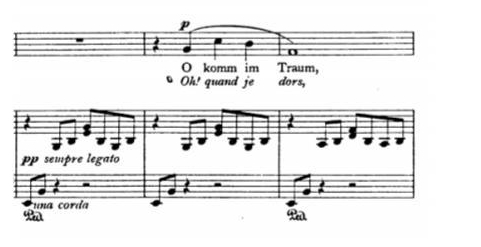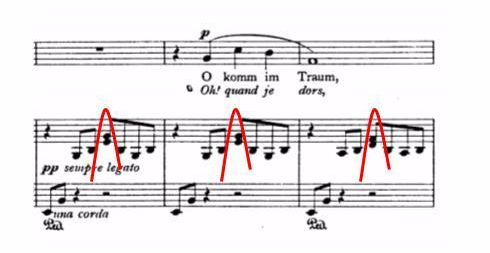Today I started learning Liszt’s O quand je dors to play with a friend. As I sightread the piece and began to write in fingerings, I split up an arpeggio between my hands. Easy. I arrived at my solution instantly; it is second nature to me now. Yet I didn’t always know how to divide notes this way. With the hope that one of my readers can benefit from this, I will pass along my secret!
After the introduction of the song, Liszt writes an accompaniment pattern that looks like this:
O quand je dors measures 8-10:

It is possible for me to play it as written. However, my right hand would jump around a lot, and it would be difficult to play with control and sempre legato.
Here’s what I do instead:

By taking the peak of each arpeggio in my left hand, my right hand can hover over two notes (the low G# and B in measure 8). My left hand has plenty of time to travel to and from the bass notes, and the pattern feels and sounds smooth. Liszt repeats this figuration for about two pages, and my solution works every time! Ta-da!
I divide arpeggiated passages like this often. Sometimes the patterns are much trickier, so the solution is not immediately obvious. Occasionally I will practice one solution for days, only to find something better. A good solution makes all the difference!
Before ending this post, I would feel amiss if I didn’t mention one of the perils of breaking up lines into small chunks: it is easy to play unevenly. I can still hear Arlene’s voice telling me not to make “two note groupings” by rushing the notes in my right hand. She called me out on it every time. And I am a better pianist for it.
**Added July 2017**
Here is a video of the entire piece. The audio quality is not great, but you can watch my hands.
No video (private) ;(
LikeLike
Fixed!
LikeLike
Sorry the audio is fuzzy… someday I’ll invest in better recording equipment…
LikeLike
I just added a video for the entire piece!
LikeLike